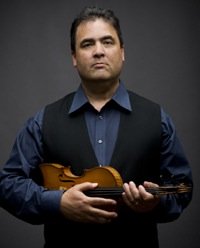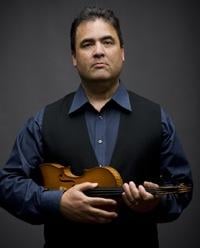
Musicians, like other species, mutate and adapt to survive — or, in the case of groups like the pioneering Bay Area–based Turtle Island String Quartet, simply because doing so captivates them and stirs the juices that got them going in the first place. Oh, yeah: Adding some screaming licks based on the most celebrated psychedelic-era musician of all time never hurts, either.
This double-Grammy-Award-winning group is now celebrating its 25th anniversary with two San Francisco Performances–sponsored concerts on Dec. 10 and 11 (the latter a specially priced family matinee), where it will perform songs from its latest CD, Have You Ever Been ..., a tribute to Jimi Hendrix’s iconic album, Electric Ladyland. The program will feature guests Mike Marshall on mandolin and jazz piano prodigy Cyrus Chestnut, in addition to TISQ members Mark Summer, Mads Tolling, and Jeremy Kittel.
San Francisco Classical Voice caught up with TISQ violinist David Balakrishnan by phone at his Albany home. He’s looking forward to the San Francisco gig, saying, “It will be a great party! You should come.”
You’ve been a Hendrix fan since you were a kid growing up in Los Angeles. Why was he such a powerful influence?
Hearing Jimi was kind of like the primary phrasing foundation of my life, although I don’t think I thought of it in quite those terms at the time when I was a kid [laughs]. I was playing the violin within the tradition of the school systems, which were good and still are — I’m amazed by the strength of the string culture in America — but it was still like doing homework. Growing up in the ‘60s, rock ‘n’ roll was getting going, and we were all in love with the guitar. I got one to noodle around with when I was 13, like a million other kids, and Hendrix’s sound was the one I completely fell in love with. He was so far above and beyond everyone else at the time that it was, like, a million light years away.
I heard him twice at the L.A. Forum, first with the Experience, and then with Band of Gypsies, and I remember my mouth falling open, and experiencing a feeling of astounding joy. How could you ever feel that way again? It’s like falling in love for the first time. That’s what created the first intense love of music for me, not playing classical music. But, listening to Hendrix, I realized that I could do that on violin ... the guitar player uses the amp and all those tricks to create a sustained sound, like a violinist would play with a bow. If you try to do that with an acoustic guitar, it just goes plunk. So I was one of the fortunate ones who got to go off the page and start playing licks.
I was OK on guitar, but realized that I was better on violin. Plus, there were some other violinists playing rock at the time — David LaFlamme [of It’s a Beautiful Day]; Papa John Creach; Sugarcane Harris, who played with John Mayall and the Bluesbreakers; and Jean-Luc Ponty and the Mahavishnu Orchestra had a violinist. So it wasn’t unknown.
Featured Video
All Along the Watchtower
Related Article
CD Review: Crossover Traffic
November 23, 2010
Buy Tickets
Turtle Island String Quartet with Mike Marshall, mandolin and Cyrus Chestnut, piano
Venue: Herbst TheatreCity: San Francisco
Date: December 10, 2010 8:00 PM
Price Range: $50/$40/$30
Was [Hendrix] burning his guitar at the end of the gig when you saw him?
No. I saw him toward the end. It was his last year, and when I read about it now, I know it was his last year, and he was pretty tired and was going through a lot. But it’s fascinating to look back. A lot has happened in my life since then. Each one of us in Turtle Island has a similar story of how, as a child, we’ve gotten off the page. It’s not crossing over — as [bassist] Edgar Meyer told me, “You’re not crossing over, you’re already there” [laughs]. It’s kind of a bipolar thing. I started out studying for a master’s degree and composing music, and then discovered more-complicated vocabularies like jazz, 12-tone composition, fiddle music, and then Indian music — my father’s from India. So this record represents the culmination of the past 25 years, in a certain way.
One thing Turtle Island can do successfully is play the music of great American nonclassical master musicians like [John] Coltrane and Jimi. This whole thing started when we played a gig back east in Bethel Woods, where Woodstock took place, and I kind of hung out in the museum there where they had a clip of his performance. The camera homed in on him, and I saw him recognize the camera, which would be a very scary moment for the rest of us mere mortals, and I could see it in his eyes that he wasn’t scared at all, that he was determined to play the most outrageous show possible. So I just thought, This is an American musical genius, and we need to represent him. I didn’t see it as a great commercial idea, but I knew others might see it that way, so I held onto it for a while before we got started on the recording. To me, it was like holy ground.
You’ve said you want him to be appreciated as a composer, not just as a performer and guitarist?
Yes, listening to Electric Ladyland is very interesting, because it’s one of the first extensively overdubbed records in rock 'n' roll. It’s in the same spirit as someone like Bobby McFerrin, who composes by overdubbing these amazing rhythmic melodic parts and orchestral lines. What a composer Hendrix was!
Since you’re such a fanatic on the subject, did the other members of the group think, Oh, this is David’s thing?
[Laughs.] Well ... not only that: Two of the guys in the group are in their 20s. But Hendrix is such a huge voice — nobody could ignore that he’s a great musician. You could maybe find fault with some of those old recordings; there’s plenty to be critical about. But people had to trust that I could help them make it work. Honestly, at first I forced us all to just stare at the page. I’d say, “I don’t want you to play this stuff like it’s just a part.” So we’d all go home with assignments: “See if you can capture the sound on the violin and explore ways to make the textures work.” Very often, when you’re arranging someone’s music you can change it, recompose it if you will, but that’s not what happened in this case.
You’ve written your own Hendrix-inspired composition, Tree of Life, sections of which also appear on the new album. How do they fit in?
When I wrote Tree of Life I wasn’t thinking so much about Hendrix. It’s more that it represents me at a mature stage as a composer, and something very deep about what Turtle Island’s all about. String quartets are more known as a mirror of the culture than presenting original music. But if you look at role models like Steve Reich and Philip Glass, that’s something that’s unique to Turtle Island that we deliver on: the ability to transcend style.
One of the things we’re really known for is playing jazz pieces, which is great, but can be a bit frustrating, like being a cover band or something. But there is a link, because the Hendrix sound was so much a part of how I hear music in a bedrock way. The language of how he played is the same way he composed. There’s something called a “Hendrix chord” that musicians know about — it’s a sharp nine [an interval], that he used on Purple Haze and Foxy Lady that has a stretchy feeling that makes you feel like you’re being pulled, in all kinds of ways. It’s messy energy — not necessarily dark, but primal, in a way.
Keith Richards is getting a lot of attention for explaining the mysteries behind his guitar riffs (and Mick [Jagger]) in his new autobiography. Would you consider doing an album of Stones material — say, Exile on Main Street?
The problem is, how far would you go down that road? We’re a group that takes a huge swath through so many styles, but what makes it work is focus on our individual connections with the music. I love the Rolling Stones, but I don’t know that I would want to cover a whole album of their work, though I could certainly see doing individual songs. A lot of other quartets are playing rock 'n' roll covers, so in a way it’s already being done. Our thing is our thing.
The most important thing is to stick to your original vision. After 25 years, even though there have been tremendous pressures to be pulled sideways, Turtle Island is still based exactly on what I had in 1981, when I was dreaming about a string quartet of four players grounded in jazz and classical music, and which ultimately resulted in the founding of the group in 1985. It was a way for violinists to get off the page. It wasn’t a career path, although it has become one now, to some extent, with an academic pathway for eclectic styles.
The thing you look for is a way to find your way through confusion. If you take a wide range of styles, like we do, there are times when you can only go so far in any direction. That’s the thing you surrender. But you look for a lot of diversity, and then find a place to organize that diversity.
The group takes its name from Gary Snyder’s poem about the need to unite indigenous culture with the colonized. Have you ever met Snyder?
We contacted him at one point to try to do a project, but I don’t really know him. He’s kind of a formidable guy. He’s famous and older, someone you have to be careful in approaching. But something might happen with Gary that he doesn’t know about yet.
Getting back to the upcoming concert, what’s it like collaborating with Mark, Mike, Cyrus, and the others?
What amazing musicians! This is where you can get into the meat and potatoes of Turtle Island. One of the ways we make music work is that we’re all not only improvisers, but Mark Summer, in addition to being a top-notch classical player, of course, knows how to create a jazz rhythm section. He’s got a little bit of James Brown in him. I introduce him as “on cello, bass, and drums, the one-and-only Mark Summer.” So we go between two worlds. I feel, when I get to play with someone like Cyrus, who I’ve been imitating for years, that I’m a hybrid, an early Prius. When he does a song like “Crossroads,” he turns it into this jazz-bluesy thing. First there was the Eric Clapton version, and then he sounds like he’s in a bar, which is of course how all this music started.
You’re playing Vince Guaraldi [who composed scores for the Peanuts TV shows] at the concert. Who are you more like, Linus or Lucy?
[Laughs.] Oh, my goodness. ... Of course, Linus comes to mind, but maybe a little bit of Lucy. I can be a bit of a tease. I’d rather be a Linus, but the truth is I’m probably more of a Lucy. I can throw a monkey wrench in the works and be annoying!

